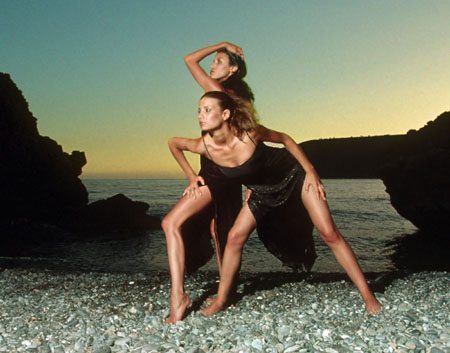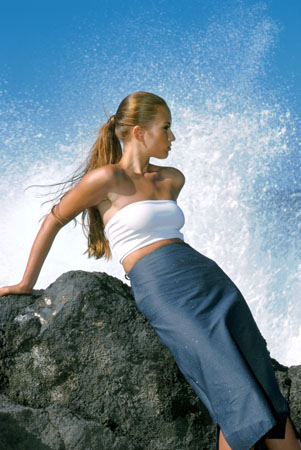
Natural light is beautiful and a great source of illumination for fashion work. However, it needs a bit of a helping hand to achieve the best and most flattering results.
On a clear day, direct sunlight is very harsh and generated deep unsightly shadows all around and over the model. The human face incorporates complex forms and overhead light generated shadows beneath the eyes, nose and chin. Contrast can be so great that these shadows are virtually black. The immediate solutions are to fill the shadows using appropriate reflectors or flash. Alternatively, work at a time of day when the sun is at a lower angle - maybe within a couple of hours of sunrise or sunset. In the case of the image of the two models in black, the sun had dipped below the horizon and darkness was descending rapidly. Flash was used the light only the models, allowing the background to be recorded as it actually appeared at the time.
The best direction for the light when the sun is shining depends upon what sort of images are required. The safest approach is to keep the sun behind the camera, but not directly so. Light falling on the model from an angle of 30 or 45 degrees helps to emphasize her form in an attractive manner. It also removes the problem of lens flare. Light falling from directly behind the photographer tends to flatten the model's features and produce an uninteresting image.

Perhaps the most interesting images are obtained when the sun is positioned behind the model. Lighting of this nature produces a silhouette which must be filled with appropriate levels of flash and light returned to the model's face from reflectors. Keeping the sun behind the model also removes all shadows from her features and averts the problem of her squinting in to the bright light. However, care must be taken to avoid producing a similar effect by placing very bright reflectors close by.
On a day when a few puffy clouds are crossing the sky, wait until the sun is obscured by a cloud and the light has become more diffused. Clouds act as giant soft boxes and spread the light in countless directions. The result is that the lighting becomes much softer and kinder to the face of a model. Contrast reduces quite a bit - ie highlights are toned down and the shadows are much less black. At this time, flash can be used to inject more fill so that the overall lighting becomes soft and flattering.
On overcast days the light can be rather too flat, so flash must be used to introduce some sparkle into the images. Be careful not to over fill the shadows because this produces a "flashed" appearance and may surround the subject with an unwanted shadow if the background is reasonably close.
Light is of course far from the only consideration when working outdoors. An interesting location must be found which suits the purpose of the images and which provides a reasonable degree of privacy. The presence of a few attractive young women in interesting and stylish clothes soon produces an audience. This creates a distraction for the models and the photographer, and the model's eyes will inevitably be diverted at some moments. Some onlookers even produce cameras an try to steal images.
Natural surroundings are often very attractive for this type of work although much will depend upon the purpose for which the images are being created. Clothes for business people may be best modeled in an urban environment, casual or countryside fashions in rural surroundings, and swimwear on or near a beach. The model in the image above was photographed on a Mediterranean island on a very windy day. She was positioned on coastal rocks against which large waves were breaking. The spray was rising up to ten feet above sea level and the crashing waves were sufficient to cause the model a degree of alarm. At the risk of soaking the camera gear, a series of images showing a backdrop of spray was eventually obtained.






